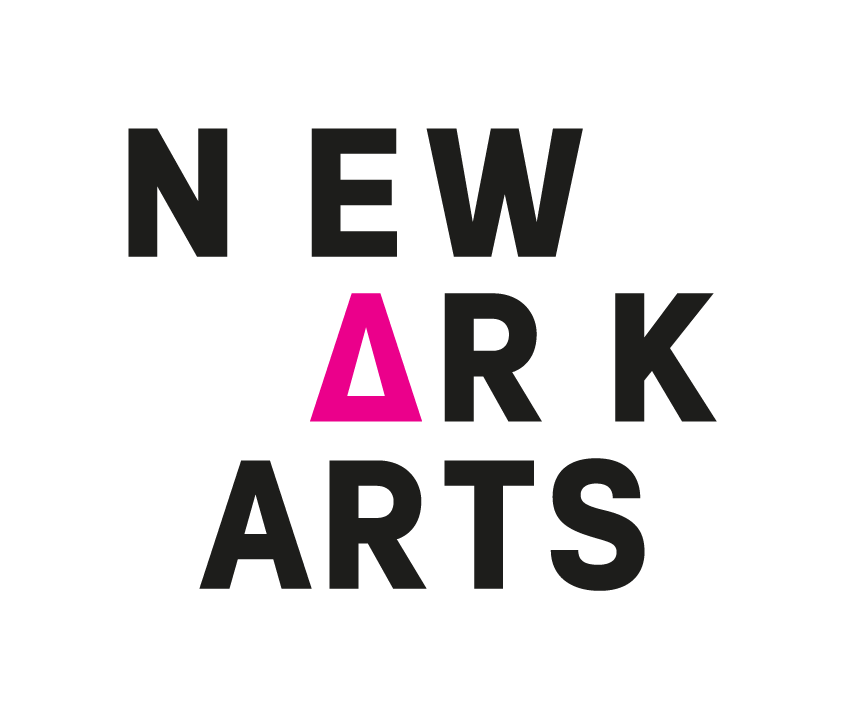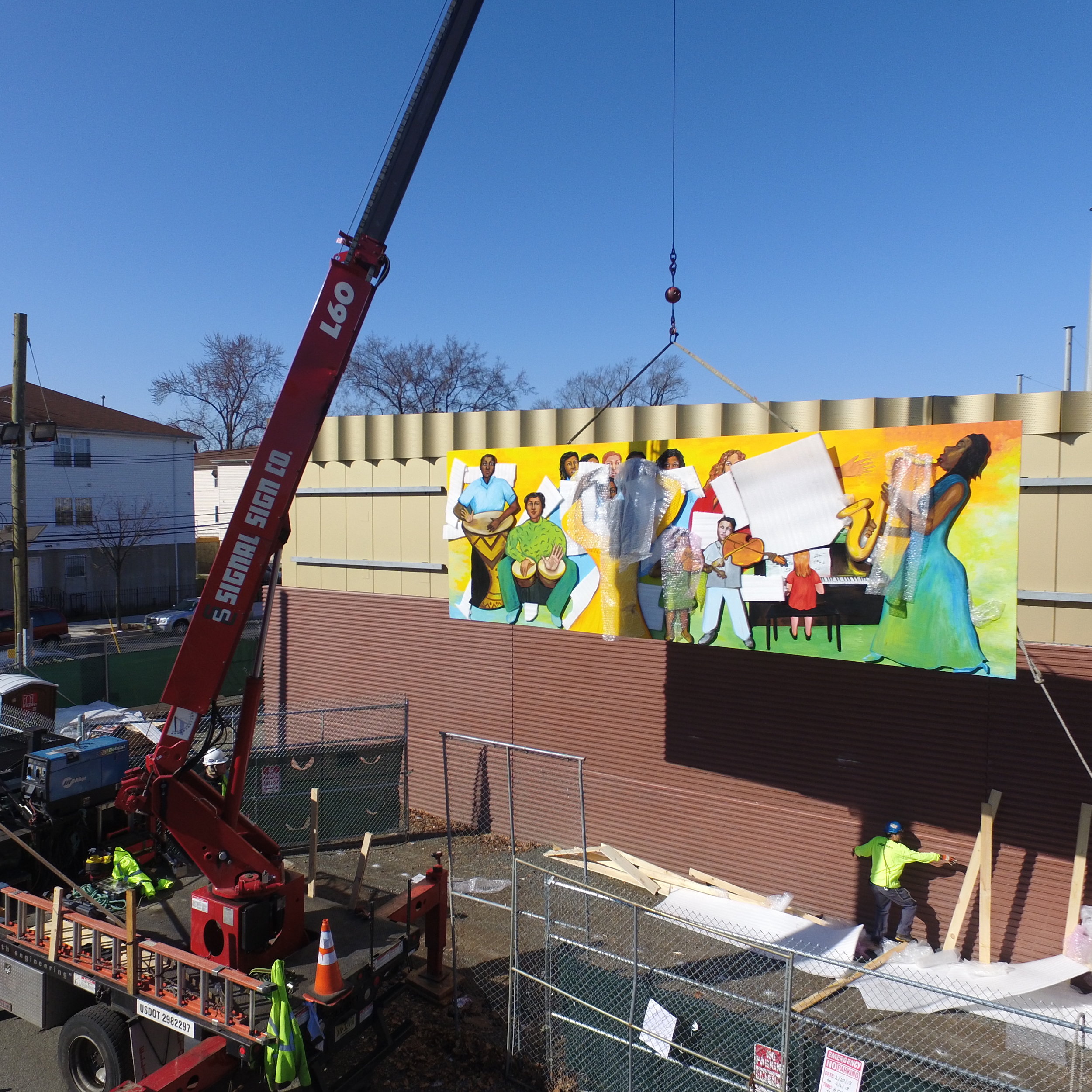Siddhartha Mitter
It was a mild April day, earlier this year. The scene was an industrial site: A switchyard—the thicket of machinery that takes high-voltage electricity and steps it down to the current you use when you turn on the lights.
Around the installation, which sprawled across a double-sized city block in Newark’s West Ward, ran an elegant wall. Its lower part was concrete, but the color of pink granite, streamlined with horizontal grooves. The upper part consisted of gold-toned aluminum panels with tiny perforations, through which the transformers appeared like ghostly skeletons, if you noticed them at all.
That was one part of the achievement. The other part was the art. Fourteen works of sculpture, mosaic, and other forms were spaced along the wall, facing the neighborhood. Resolutely modern, they would have made a strong gallery exhibition. But here they were permanent, crafted to withstand the elements, defining this place.
Six were the work of Newark artists: Willie Cole, world-renowned sculptor; Gladys Barker Grauer, doyenne of the city’s Black art scene; Jerry Gant, sculptor, muralist and Newark savant; Manny Acevedo, Kevin Darmanie, Kevin Sampson. The rest were by artists from Brooklyn, Cleveland, Florida—a group of world-class talents, diverse in age and background, with an orientation to community in their practice. Curators Victor Davson, co-director of Express Newark and longtime champion of Newark arts, and Danny Simmons, founder of the Rush Philanthropic Arts Foundation, selected the artists.
As for the wall itself, and adjacent plaza—a natural gathering place with its striking red colonnade— their designer was David Adjaye, the influential British-Ghanaian architect, known in the U.S. for leading the design of the National Museum of African American History and Culture in Washington, D.C.
All this local and global excellence assembled off West Market Street, in the shadow of the Georgia King Village towers, to a practical end: Turning a utility facility, necessary to strengthen Newark’s key infrastructure, from potential eyesore to community asset.
“We’ve finally figured out the trick,” Mayor Ras J. Baraka told the crowd gathered to unveil the Fairmount Art Wall. People have fretted over Newark’s revitalization for fifty years—the longest renaissance in history, Baraka joked. Here was a method that worked. “Collaboration, and the second thing is art. That’s the secret sauce.”
However you label it—revitalization, development, gentrification—Newark has accelerated its changes. Two decades of effort under three mayors—Sharpe James, Cory Booker, and since 2014, Baraka—has consolidated the renewal downtown. Prudential Financial has expanded its footprint, Audible and Panasonic are established, Whole Foods and Starbucks have shown up, there’s a beer garden in Military Park. A lot of spending power still leaves town at 5 p.m., but connoisseurs know to stick around. Crime is down. Condos are up. So is Newark’s image, suddenly becoming a brand.
Artists helped it happen. A constellation of Newark artists across the five wards stuck with the city in tough times, documented and expressed Newark life, reinforcing its pride and resilience. Then came fresh waves of artists, local and from elsewhere, who found in Newark’s vacated industrial and commercial buildings the space for experiments, for mutual support, for a community ethos. Index Art Center, Gallery Aferro, and Project for Empty Space are among the artist-built ventures that became, in their own way, Newark institutions, and helped radiate Newark’s creative life into the world.
According to a recent study, the non-profit arts sector in Newark generated a total economic impact of $178 million in 2015. But that impressive aggregate says more about the industry as a whole—and big players like NJPAC and the Newark Museum—than about the actual lives of artists, or about sustained access to art for the city’s people. At ground level, the fabric can fray. This year, the community-focused gallery City Without Walls, established in 1973, has closed. Aljira, A Contemporary Center for the Arts, whose gallery and artist programs put Newark on the global contemporary-art map starting in 1983, has also shut for now, as it embarks on a transition. It’s not unusual for art spaces to close after a long run. But if downtown Newark becomes the nexus of a high-rent enclave, financially and culturally insulated from the rest of the city, the art life will change as well—in demographics, collective purpose, and creative energy. That brings us back to Fairmount. For 20 years the site was moribund, home to the husk of a factory and a vacant church laced with asbestos. When news spread that PSE&G, the utility, had purchased the land to parachute a switchyard into a residential area, an outcry followed. The negotiations produced measurable commitments: local jobs, procurement, payments by the utility in lieu of taxes. But putting time and money into architecture and art, paying artists and curators, connecting them with residents in a collaborative design process—all this signals something intrinsic, the value of a place and its people.
Newark is still a high-poverty city despite pockets of prosperity. How will areas like Fairmount participate in its next phase, and on whose terms? The city government has made jobs and training for Newarkers a priority, in partnership with large employers. But land and space—who owns the city, what does it look like, whom does it welcome—can be more elusive to address. Art can play a micro-level, mitigating role in neighborhoods, as murals and other projects have done. Or it can aim for more.
The situation is clear. Newark is in a fortunate position: It has an economic growth dynamic, a proud cultural history, and a dynamic creative scene with national and global resonance that is still independent, alternative, and grassroots. You don’t have to look far afield (hello, Brooklyn) to realize that window could quickly close.
The Art Wall, as both outcome and process, forms an example of successful integration of urbanism and art. It must be just the beginning. Self-reliance and self-determination are crucial—for instance through community land trusts, before outside interests take control via land-banking. There are other strategies that can connect artists and neighbors in communities of interest and affect. The city, if so minded, can offer a boost.
Inaugurating the Art Wall, Baraka—a poet, and the son of great radical artists—lauded the prospects it beckoned. “We work together, and we paint, and we build, and we draw, and we read poetry; we do all those things, and Newark is on fire again,” he said. Adjaye, the architect, was more measured. The project seemed unlikely at first, he said. And yet here was an elegant solution, instructive for the city at large. “The opportunity seemed complicated,” Adjaye said. “That’s when creativity has to rise to the opportunity.”

